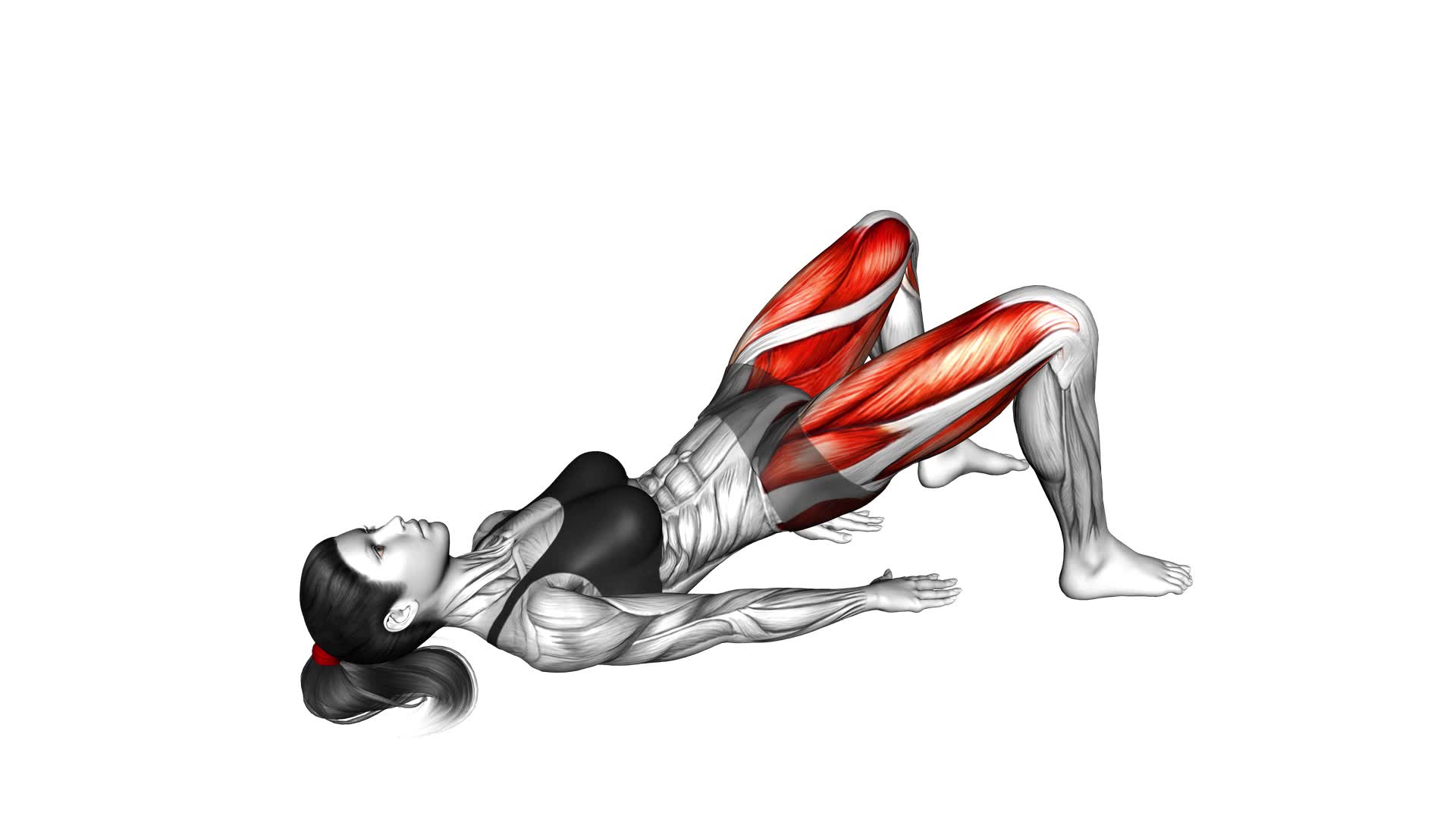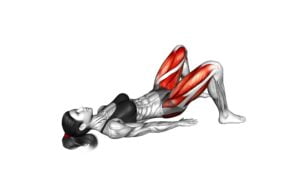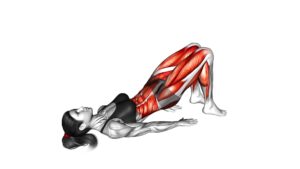Wide Glute Bridge (female) – Video Exercise Guide & Tips

Are you looking to strengthen your glutes and improve your overall lower body strength? Look no further than the wide glute bridge!
Watch This Exercise Video
In this video exercise guide, we'll show you the proper form and technique for performing this exercise. We'll also cover common mistakes to avoid and provide tips on how to progress and target different muscle groups.
Get ready to activate your glutes and achieve a more toned and strong lower body. Let's get started!
Key Takeaways
- The wide glute bridge targets glute muscles for strength and toning.
- It improves glute activation and overall lower body strength.
- It enhances athletic performance in running, jumping, and squatting.
- The wide glute bridge can be easily modified for different fitness levels and goals.
Benefits of the Wide Glute Bridge
You can experience numerous benefits from incorporating the wide glute bridge into your workout routine. The wide glute bridge is a versatile exercise that targets your glute muscles, helping to strengthen and tone them. One of the main benefits of the wide glute bridge is that it can be easily modified to suit your fitness level and goals. There are various glute bridge variations that you can try, such as single-leg glute bridges or weighted glute bridges, to challenge yourself and continue making progress.
Another benefit of the wide glute bridge is that it's a great glute activation exercise. By performing this exercise, you can effectively activate your glute muscles, which are often underutilized in daily activities. This can help improve your overall lower body strength and stability. Additionally, incorporating the wide glute bridge into your routine can also enhance your athletic performance, as strong glutes are essential for movements like running, jumping, and squatting.
Proper Form and Technique
To ensure proper form and technique during the wide glute bridge exercise, it's important to focus on engaging your glute muscles while maintaining a stable and aligned position. Here are some tips to help you perform the exercise correctly:
- Keep your feet hip-width apart: Placing your feet too close together or too far apart can affect the activation of your glute muscles. Make sure your feet are positioned at a comfortable distance.
- Squeeze your glutes at the top: As you lift your hips off the ground, focus on squeezing your glute muscles at the highest point of the movement. This will maximize the activation and effectiveness of the exercise.
- Maintain a neutral spine: Avoid arching your back excessively or letting it round. Keep your spine in a neutral position throughout the exercise to prevent any strain on your lower back.
- Control the movement: Slowly lower your hips back down to the starting position, maintaining control and avoiding any sudden movements. This will help you engage your glutes more effectively and reduce the risk of injury.
Common misconceptions about the wide glute bridge include relying solely on the hamstring muscles or using momentum to lift the hips. Remember to focus on engaging your glutes and maintaining proper form for optimal results.
If you're looking for alternative exercises to target your glutes, you can try hip thrusts, single-leg glute bridges, or sumo squats. These exercises can provide variety and challenge your glute muscles in different ways. Remember to always listen to your body and choose exercises that suit your fitness level and goals.
Common Mistakes to Avoid
When performing the wide glute bridge, it's important to be aware of common mistakes to avoid. Incorrect form can lead to potential dangers such as strain or injury.
Additionally, not properly warming up before attempting this exercise can increase the risk of injury.
Overtraining is another mistake to avoid, as it can lead to fatigue, muscle imbalances, and decreased performance.
Incorrect Form Dangers
Using improper form while performing the wide glute bridge exercise can lead to potential dangers and common mistakes to be aware of. It's crucial to prioritize proper technique to ensure a safe and effective workout.
Here are four common mistakes to avoid when performing the wide glute bridge:
- Arching your lower back excessively: This can strain your lower back and take the focus away from your glutes.
- Allowing your knees to cave in: This can put unnecessary stress on your knees and reduce the effectiveness of the exercise.
- Lifting your hips too high: This can shift the workload to your lower back instead of targeting your glutes.
- Rushing through the movement: By not maintaining control and rushing, you may not fully engage your glute muscles and increase the risk of injury.
Inadequate Warm-Up Risks
By neglecting a proper warm-up, you put yourself at risk for inadequate preparation and potential mistakes during the wide glute bridge exercise. Warm-up is of utmost importance as it helps to prepare your body for the physical demands of the exercise. It increases blood flow to your muscles, raises your body temperature, and improves joint flexibility. A good warm-up also helps to activate the muscles you'll be targeting, ensuring they're ready for the exercise.
Neglecting this crucial step can lead to injury and hinder your performance. By properly warming up, you reduce the risk of strains, sprains, and muscle pulls during the wide glute bridge. It's essential to prioritize injury prevention and maximize the benefits of your workout routine.
Now, let's move on to the next section and explore the risks and consequences of overtraining.
Overtraining Risks and Consequences
To avoid the risks and consequences of overtraining, it's crucial for you to maintain a balanced workout routine and listen to your body's signals. Overtraining occurs when you push your body beyond its limits without giving it enough time to recover. This can lead to various negative effects on your physical and mental well-being.
Here are four key points to remember for overtraining prevention and to recognize the signs of overtraining:
- Gradually increase your workout intensity and volume to avoid sudden spikes in training load.
- Allow for rest days in your training schedule to give your body time to recover and repair.
- Pay attention to warning signs such as persistent fatigue, decreased performance, and increased susceptibility to illness.
- Adjust your training program as needed to prevent overtraining and maintain optimal fitness levels.
How to Progress the Wide Glute Bridge
To progress the Wide Glute Bridge, there are two key points to focus on.
First, you can add resistance by using a resistance band or placing a weight on your hips. This will challenge your glutes and help you build strength.
Second, you can increase the range of motion by elevating your feet on a step or bench. This will engage your glutes even more and make the exercise more challenging.
Adding Resistance for Progress
How can you increase the intensity of the Wide Glute Bridge exercise to make progress? Here are four ways to add resistance and take your glute bridge to the next level:
- Resistance Bands: Place a resistance band just above your knees or around your thighs to add extra resistance as you lift your hips.
- Weighted Bridges: Hold a dumbbell or a barbell across your hips while performing the glute bridge to increase the load on your glutes.
- Single-Leg Variation: Lift one leg off the ground and perform the glute bridge on the other leg. This will intensify the exercise and target each glute individually.
- Elevated Surface: Place your feet on an elevated surface like a bench or step to increase the range of motion and challenge your glutes even more.
Incorporating these variations will help you progress and continue challenging your glute muscles for maximum gains.
Increasing Range of Motion
To increase the range of motion for the Wide Glute Bridge exercise, focus on extending your hips higher towards the ceiling. Increasing flexibility in your hip flexors and hamstrings will help you achieve a greater range of motion. Stretching exercises such as lunges, hip flexor stretches, and hamstring stretches can be incorporated into your warm-up routine to improve flexibility.
It's important to gradually increase the range of motion to prevent injuries. Pushing too hard or too quickly can strain your muscles and lead to discomfort or injury. Take it slow and listen to your body.
As you progress and feel comfortable, you can gradually increase the height of your hip extension. Now, let's explore variations of the Wide Glute Bridge to target different muscle groups.
Variations to Target Different Muscle Groups
To target different muscle groups, try incorporating variations of the wide glute bridge exercise. By modifying the movement slightly, you can engage specific muscles to maximize your workout. Here are four variations to help you target different muscle groups:
- Single-leg Glute Bridge: Lift one leg off the ground and perform the glute bridge exercise with the other leg. This variation increases the intensity and activates the glutes and hamstrings even more.
- Banded Glute Bridge: Place a resistance band just above your knees and perform the wide glute bridge. The resistance from the band adds extra tension, targeting the outer glutes and hip abductors.
- Weighted Glute Bridge: Hold a dumbbell or barbell across your hips while performing the wide glute bridge. Adding weight increases the resistance, making it an advanced exercise that targets the glutes and lower back.
- Elevated Glute Bridge: Place your feet on an elevated surface, such as a step or bench, and perform the wide glute bridge. This variation increases the range of motion and targets the glutes and hamstrings from a different angle.
Incorporating these variations into your glute bridge routine will help you target different muscle groups and achieve a well-rounded lower body workout. Remember to start with variations for beginners and gradually progress to more advanced glute bridge exercises as you build strength and stability.
Tips for Maximizing Your Glute Activation
To maximize your glute activation, focus on squeezing your glutes throughout the entire exercise. This is one of the most important glute activation tips for maximizing results.
When performing the wide glute bridge exercise, it's crucial to engage your glute muscles by consciously contracting them. This will ensure that you're targeting and activating the glutes effectively.
In addition to focusing on the squeezing motion, it's important to maintain proper form throughout the exercise. Keep your core engaged and your back flat on the ground. This will help you isolate the glutes and prevent other muscles from taking over.
Another tip for maximizing glute activation is to use proper resistance. Choose a weight or resistance band that challenges you without compromising your form. This will help to stimulate the glute muscles and promote growth and strength.
Lastly, don't rush the exercise. Take your time with each rep and focus on the mind-muscle connection. Visualize your glutes working and actively engage them with each movement. This will ensure that you're maximizing your glute activation and getting the most out of your workout.
Frequently Asked Questions
Can the Wide Glute Bridge Help With Lower Back Pain?
The wide glute bridge can definitely help with lower back pain. By engaging your glutes and strengthening your core, this exercise can provide support and stability to your lower back.
Additionally, the wide glute bridge benefits include targeting and toning your glutes, hamstrings, and hip muscles. There are also variations of the wide glute bridge that you can try to challenge yourself further and work different muscle groups.
Incorporating this exercise into your routine can help alleviate lower back pain and improve overall strength and stability.
How Often Should I Perform the Wide Glute Bridge Exercise?
To reap the benefits of the wide glute bridge exercise, it's important to consider its frequency. How often should you perform it?
Well, the ideal frequency for this exercise is 2-3 times per week. By incorporating it into your routine regularly, you can strengthen your glute muscles, improve your hip stability, and even enhance your overall athletic performance.
Can the Wide Glute Bridge Exercise Help in Improving Posture?
Performing the wide glute bridge exercise can have several benefits for your overall body alignment and posture. By engaging your glute muscles, this exercise helps to strengthen your core and stabilize your pelvis, which can contribute to better posture.
Additionally, the wide stance in the glute bridge targets different muscles in your hips and glutes, helping to improve their strength and flexibility.
Incorporating the wide glute bridge into your workout routine can be a great way to improve your posture and overall body alignment.
Is It Normal to Feel Soreness in the Glutes After Performing the Wide Glute Bridge?
Feeling soreness in your glutes after doing the wide glute bridge is totally normal. It's a sign that your glute muscles are being activated and strengthened. This exercise specifically targets your glutes and helps improve their strength and overall function.
Are There Any Modifications or Alternatives for Individuals With Knee or Hip Issues?
If you have knee or hip issues, it's important to find knee-friendly modifications and hip-friendly alternatives to the wide glute bridge exercise. These modifications and alternatives can help you work your glutes without putting too much strain on your knees or hips.
Conclusion
In conclusion, the wide glute bridge is a highly effective exercise for targeting and strengthening the glute muscles. By maintaining proper form and avoiding common mistakes, you can maximize your glute activation and see great results.
Additionally, progressing the exercise and incorporating variations can help target different muscle groups and further enhance your workouts. Remember to always listen to your body and adjust the intensity as needed.
Keep up the good work and enjoy the benefits of a strong and toned gluteus!

Author
Years ago, the spark of my life’s passion ignited in my mind the moment I stepped into the local gym for the first time. The inaugural bead of perspiration, the initial endeavor, the very first surge of endorphins, and a sense of pride that washed over me post-workout marked the beginning of my deep-seated interest in strength sports, fitness, and sports nutrition. This very curiosity blossomed rapidly into a profound fascination, propelling me to earn a Master’s degree in Physical Education from the Academy of Physical Education in Krakow, followed by a Sports Manager diploma from the Jagiellonian University. My journey of growth led me to gain more specialized qualifications, such as being a certified personal trainer with a focus on sports dietetics, a lifeguard, and an instructor for wellness and corrective gymnastics. Theoretical knowledge paired seamlessly with practical experience, reinforcing my belief that the transformation of individuals under my guidance was also a reflection of my personal growth. This belief holds true even today. Each day, I strive to push the boundaries and explore new realms. These realms gently elevate me to greater heights. The unique combination of passion for my field and the continuous quest for growth fuels my drive to break new ground.







